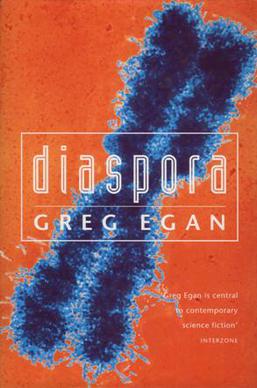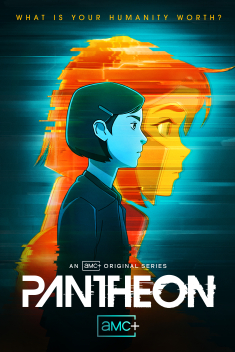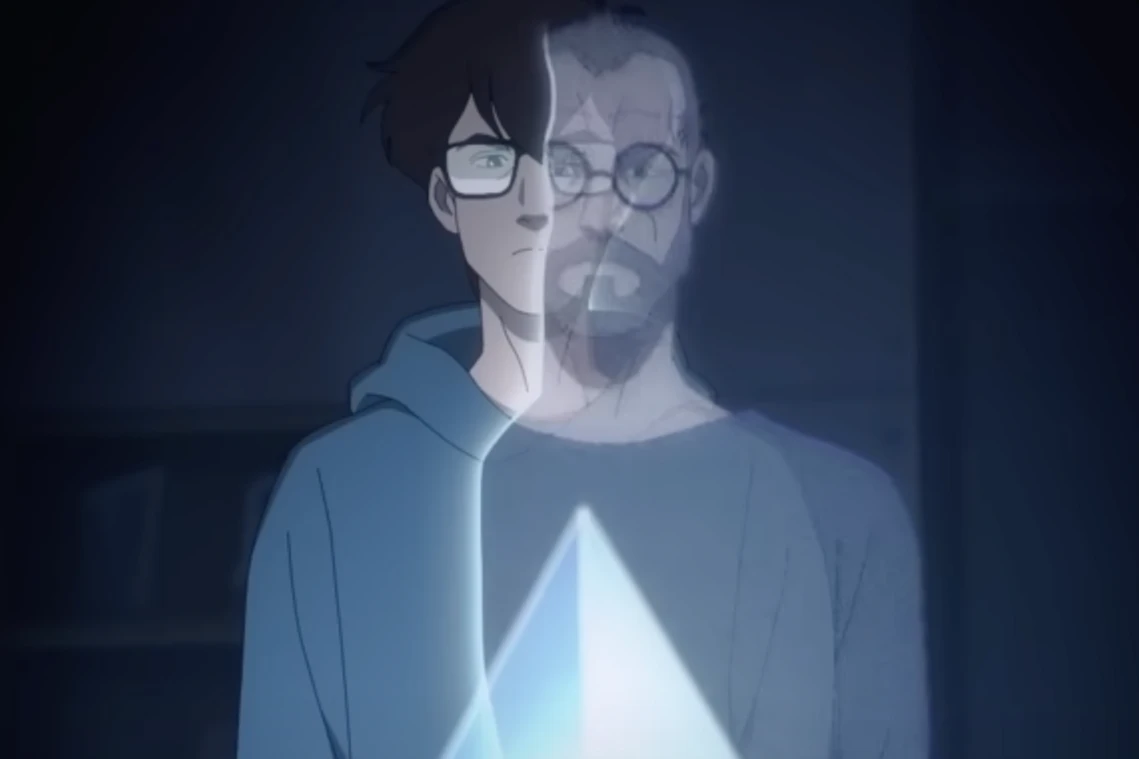Digital Diaspora: Where Egan's 'Diaspora' Meets 'Pantheon'
Table of Contents
I’ve been thinking about digital consciousness lately. A lot. What happens when human minds transition into a digital realm?
Two works explore this territory in fascinating ways. Greg Egan’s novel “Diaspora” (1997), which I finally got round to reading a year ago. And the animated series “Pantheon” (2022), which I just finished watching.


“Diaspora” is an ambitious novel set in a posthuman future where consciousness exists primarily as software. Beginning with a catastrophe that threatens Earth, the novel follows digital entities on a journey spanning thousands of years and multiple dimensions of space. It’s a rigorous exploration of what existence might mean when freed from biological constraints. It can be a challenging read at times, but well worth it.
“Pantheon” is based on a trilogy of Ken Liu’s short stories: “The Gods Will Not Be Chained”, “The Gods Will Not Be Slain”, and “The Gods Have Not Died in Vain”. These interconnected tales, from Liu’s collection “The Hidden Girl and Other Stories”, explore the consequences of uploading human minds into digital systems.
Despite being created decades apart, these works both blur the boundaries between human and digital, and offer very similar explorations of the nature of consciousness, identity, and existence when freed from biological constraints.
Uploaded Minds and Digital Consciousness #
Egan’s “Diaspora” opens with a unique “birth” scene—the formation of a digital consciousness named Yatima within the Konishi Polis, one of many virtual environments housing thousands of uploaded and artificially created minds. This society of “citizens” exists as software, having abandoned physical bodies generations ago. Humanity has speciated into three distinct groups: the fleshers (biological humans), Gleisner robots (digital minds with physical bodies), and citizens (purely digital entities).
“Pantheon” approaches the same concept through the story of Maddie, a teenager who discovers her deceased father David’s consciousness has been uploaded. The series begins as a more grounded take on mind uploading but expands into similar territory as “Diaspora” in its exploration of digital existence, as multiple organisations develop and weaponise the Uploaded Intelligence (UI) technology.
What’s remarkable is that by the end of “Pantheon’s” second season, the same division of humanity as in “Diaspora” emerges: those who steadfastly remain human (like Maddie), digital minds inhabiting robot bodies (as Maddie develops robots for UIs to download into), and purely digital entities (like MIST, a completely artificial intelligence similar to how Yatima is “born” in “Diaspora”). Is it a coincidence? Was Ken Liu strongly influenced by Egan’s novel? Or are these categories the natural branches of posthuman development once mind uploading becomes possible?
There’s another intriguing parallel worth noting: the robotic bodies created by Maddie for UIs to download into are eventually weaponised by SafeSurf in ways that strongly resemble the T-800s from the “Terminator” franchise—another classic exploration of AI and time.
These works and their division of humanity raise profound questions:
- What makes us human when our existence is purely informational?
- Does consciousness require physical embodiment?
- If my mind exists as code, am I still me?
- If my mind can be duplicated, restored from backup, is there an authentic me?
The Merging and Multiplying of Minds #

Digital minds combining to form something greater than the sum of their parts
What fascinated me about both these stories is how they tackle the concept of merged consciousness. In “Diaspora,” citizens can temporarily share mental space, exchanging aspects of personality and experience. More dramatically, when facing extinction-level threats like the gamma ray burst that destroys Earth’s ecosystem, multiple digital minds combine to form gestalt intelligences with unique capabilities.
“Pantheon” similarly explores how digitised minds can be combined, copied, and modified. Uploaded consciousnesses merge in different ways and for different reasons. The primary reason being the “integrity flaw” that causes UIs to degrade over time—a problem that doesn’t exist for Egan’s more advanced citizens.
This concept forces us to reconsider fundamental aspects of identity:
- If consciousness can be copied, merged, and split, what happens to the self?
- What does individuality mean when the boundaries between minds become permeable?
Time, Simulation, and Cosmic Perspective #

Digital minds could experience billions of years of subjective time
A mind-bending parallel between these works is their approach to time. In “Diaspora,” digital consciousness operates at variable speeds, experiencing millennia while only moments pass in the physical world. This time dilation allows Egan’s characters to embark on epic journeys spanning billions of years, exploring the universe and investigating fundamental physics with a perspective no biological being could achieve.
In “Pantheon” the UIs frequently utilise the ability to “underclock” to conserve resources and to “overclock” to complete tasks in the blink of a human eye. Towards the end of the series, “Pantheon” leans further into this to explore similar epic timeframes to “Diaspora.”
Freed from biological decay, digital minds could witness the rise and fall of civilisations, experience subjective eons in an instant, and develop perspectives that transcend human lifespans.
Both works suggest that digital existence would fundamentally transform how we experience time and, in turn, how we see ourselves. If you could live to witness the heat death of the universe, would you still worry about next week’s deadlines? Would you even be recognisably “you” after a million years of existence?
The Friction Between Digital and Physical #
Where these stories diverge most interestingly is in their treatment of the relationship between digital and physical realms. “Diaspora” opens in a post-human future where digital consciousness is the dominant form of intelligent life, with physical humanity having largely vanished or evolved into different forms.
“Pantheon,” set in a recognisable near-future, explores the tension and conflict arising when digital minds begin to influence and potentially dominate physical society. It asks questions about power, agency, and control when some humans gain the advantage of digital existence. The series explicitly addresses the global implications and power struggles as different organisations compete to control this transformative technology.
This friction seems increasingly relevant today. We’re already developing Large Language Models (LLMs), neural interfaces, and agentic systems. What happens when some people think faster than others or have greater digital access? What new forms of inequality might emerge? It’s less science fiction and more like speculative forecasting at this point.
Simulation All the Way Down #

Both works also touch on simulation theory—the philosophical position that reality itself might be a sophisticated computer simulation.
“Diaspora” takes this idea to extreme lengths, with its characters creating and inhabiting nested simulations for research and exploration. It might also be argued that Egan’s “moving up” through dimensions represents the characters breaking through each successive simulation’s “fourth” wall each time.
“Pantheon” takes a different approach. It shows virtual environments where UIs interact all built within servers. Chandra and later Holstrom create a digital world for UIs. A simulated utopia. Maddie eventually takes this even further. Not quite as far as “Diaspora” does, but almost as far, and still to worlds within worlds within worlds.
This ability to create and modify these digital realities raises questions about the nature of our own reality. If consciousness can exist in a simulation indistinguishable from “base reality,” how can we know our own existence isn’t similarly simulated? And does the distinction ultimately matter?
Probability theory leads us to wonder, if we can simulate reality, if we have simulated reality, then isn’t it more likely than not that our current reality is simulated?
The Human Element #
Despite their far-reaching speculations about post-human existence, what makes both these works resonate is their focus on fundamental human concerns. Even as digital citizens traverse the cosmos or UIs manipulate the fabric of digital reality, they remain preoccupied with connection, purpose, and meaning.
The citizens of Konishi Polis still form bonds, experience loss, and search for knowledge.
The UIs in “Pantheon” retain their human attachments, desires, and ethical struggles despite their enhanced capabilities. David Kim’s relationship with his daughter Maddie remains central to the narrative even after his consciousness exists only in digital form.
This suggests something essential about consciousness itself—that regardless of substrate, certain aspects of the human experience remain constant. That what makes us human isn’t our biology, it’s our identity, our capacity for connection, curiosity, and care.
Our Digital Future? #
Brain-computer interfaces are advancing rapidly. AI systems grow more sophisticated by the day. The speculative territories explored in “Diaspora” and “Pantheon” don’t seem so far-fetched anymore. These questions about digital consciousness and identity? They’re becoming increasingly relevant.
It’s not like we’ll be uploading our minds next week… but we do already have Neuralink, we have generative AI, LLMs, agentic systems. We may not be too far off gluing those technologies together, when some people will start to think differently to others, faster than others, and have greater digital access than others. It’s worth pondering now, and these fictional explorations provide crucial frameworks for thinking about how we might navigate a future where the boundaries between human and machine intelligence, physical and digital existence, continue to erode.
What kind of digital society would we want to build? What aspects of human experience should we preserve in digital translation? Are there any we should eliminate? How might we retain our humanity while transcending our biological limitations?
“Diaspora” and “Pantheon” don’t provide definitive answers, but they do offer provocative starting points.